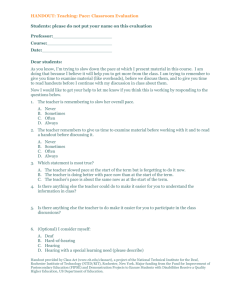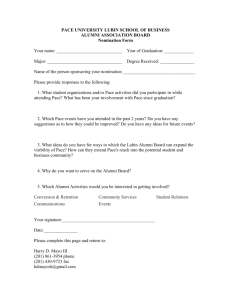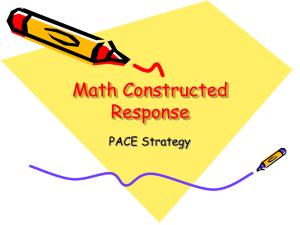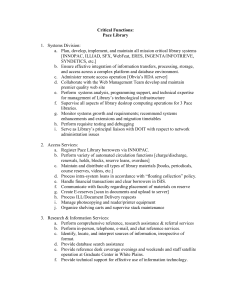nyt web-design-case-study - Seidenberg School of Computer
advertisement
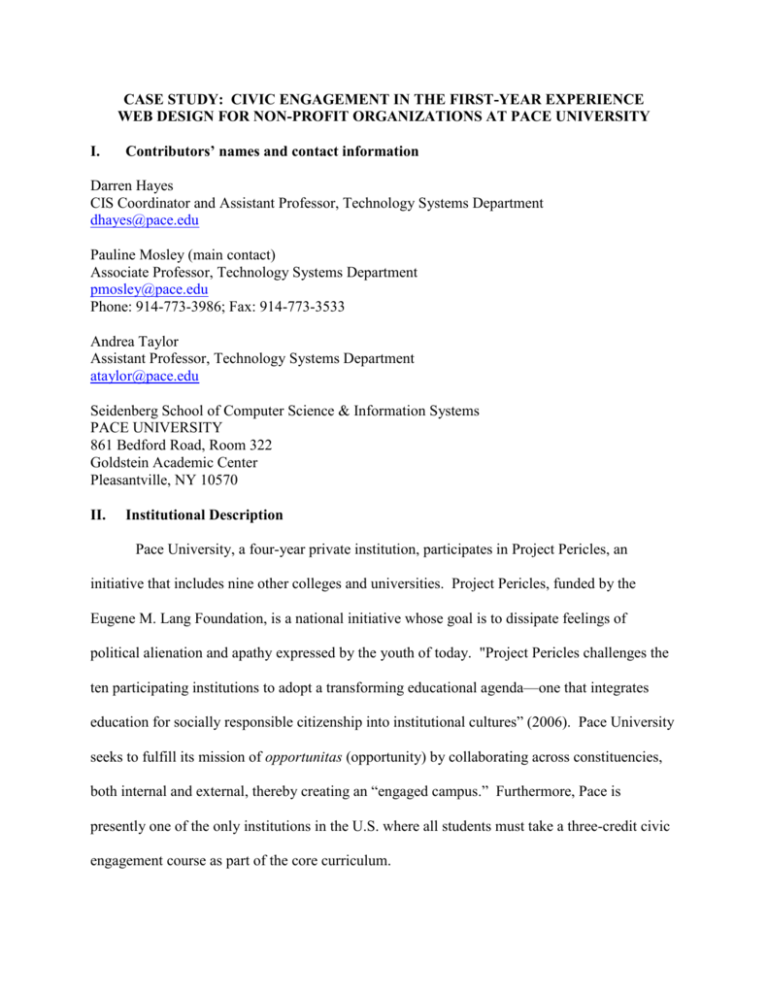
CASE STUDY: CIVIC ENGAGEMENT IN THE FIRST-YEAR EXPERIENCE WEB DESIGN FOR NON-PROFIT ORGANIZATIONS AT PACE UNIVERSITY I. Contributors’ names and contact information Darren Hayes CIS Coordinator and Assistant Professor, Technology Systems Department dhayes@pace.edu Pauline Mosley (main contact) Associate Professor, Technology Systems Department pmosley@pace.edu Phone: 914-773-3986; Fax: 914-773-3533 Andrea Taylor Assistant Professor, Technology Systems Department ataylor@pace.edu Seidenberg School of Computer Science & Information Systems PACE UNIVERSITY 861 Bedford Road, Room 322 Goldstein Academic Center Pleasantville, NY 10570 II. Institutional Description Pace University, a four-year private institution, participates in Project Pericles, an initiative that includes nine other colleges and universities. Project Pericles, funded by the Eugene M. Lang Foundation, is a national initiative whose goal is to dissipate feelings of political alienation and apathy expressed by the youth of today. "Project Pericles challenges the ten participating institutions to adopt a transforming educational agenda—one that integrates education for socially responsible citizenship into institutional cultures” (2006). Pace University seeks to fulfill its mission of opportunitas (opportunity) by collaborating across constituencies, both internal and external, thereby creating an “engaged campus.” Furthermore, Pace is presently one of the only institutions in the U.S. where all students must take a three-credit civic engagement course as part of the core curriculum. 2 Pace University's has three campuses in New York, Pleasantville, and White Plains, NY. The New York City and Pleasantville campuses consist of both commuter and residential students. The number of full-time equivalent (FTE) undergraduate students, campus-wide, is 6,007 (comprised of 951 first-year students). Table 1 provides a detailed breakdown of the student population. Table 1. Pace University FTE Student Population Pace University FTE Student Population 2006 Student Type Residential Commuter Total First-Year 787 164 951 Total Students 2,386 3,621 6,007 III. Web Design for Non-Profit Organizations In the spring of 2004, The Ivan G. Seidenberg School of Computer Science and Information Systems teamed up with NYC2012, the organization established to promote the selection of New York City, as the venue for the 2012 Summer Olympic Games, to realize the Nations of New York (NoNY) project. NoNY is an effort on the part of the City’s international nonprofit community to rally behind this bid. This partnership resulted in the course offering of Web Design for Non-Profit Organizations to all first-year students. “First-year students” are students who have earned fewer than 33 college credits or, if they have earned more than 33 college credits, they have completed college courses while enrolled in high school. Students enrolled in this course, taught on both the New York and Pleasantville campuses, developed over 200 web sites, using web design template software. This helped these multi-cultural non-profit organizations broadcast their support for the 2012 Olympics. This model was in place for a year and upon New York losing the bid, faculty teaching this course began to modify the course as 3 well as develop working relationships with various community agencies, in which students would carry out their civic learning assignments. Course Structure Students entering this course must have completed our Introduction to Computing course or have taken an equivalent course. In the introductory course, students learn to create websites using HTML. Moreover, they also learn JavaScript to incorporate dynamic elements into their sites. This course provides a strong foundation for freshmen to excel in the Web Design for NonProfit Organizations. Upon completion of the Web design course, students should be able to demonstrate knowledge of the following: o o o o o Principles of effective site design Knowledge and use of professional Web design applications Understanding of Web and Internet technologies Community service partner user requirements The role of our partner in the community and the importance of the site to their organizational goals o Web development team roles and responsibilities o Project management and effective client collaboration o Enhance presentation and communication skills Students are required to develop a web site for a non-profit organization, in the local community. In fulfillment of the course requirements, students obtain a real-world experience. Thus, by the completion of the course, the community group has an online presence. Case studies or simulations cannot offer students the same experience of dealing with the political, social, and ethical problems that exist in a workplace (Lazar & Preece, 1999). The course consists of three components: web programming, analysis and design, and web usability. Topics, such as cascading style sheets, HTML coding, web development life cycle, usability testing, and a WYSIWYG web design application, such as FrontPage, are covered. In the analysis and design portion of the course, students determine the needs of the 4 organization, examine pre-existing documentation, and gather requirements. The web usability component covers issues, such as page layout, navigation between pages, color issues, and browser compatibility. Civic Learning Models The course structure lends itself to a myriad of flexible models of civic engagement. Currently, the course is taught using one of three models (see Table 2). Each model is centered on a civic learning project that requires a student to complete a minimum of 15 hours of community service and submit a reflective journal at the end of the semester. This actively engaging civic experience goes beyond the textbook, classroom, and subject matter while raising the level of digital inclusion. Table 2. Civic Learning Models Model Model One Model Two Model Three Description A team of 3-4 students work on designing and developing a web site throughout the semester. The team has a project leader, web designer and web consultants (two consultants for a team of four). Two teams of 3-4 students work on designing and developing a web site and the non-profit organization selects which team meets their requirements. The entire class designs and develops a web site for one non-profit organization. IV. Assessment Methods/Results Assessment Objectives The project consists of several rubrics, which measure the impact of the civic engagement experience on community agency partners and students. Moreover, these rubrics measure the pedagogical effectiveness of civic teaching models, as well as the web design skill set of the students. Assessment of the Community Partners 5 At the end of the semester, data is collected from the community partner using a variety of methods, including personal interviews, interviews via telephone and surveys. The purpose is to gain an objective view of how effective we were to the community in creating a web site. Table 3 shows a sample of community agency responses to interviews and surveys which Pace conducted. A total of 30 agencies responded and Table 4 summarizes the relative frequency of the responses by the participants. Figure 1 illustrates why 93% of the agencies are satisfied with the web sites. (a) (b) Figure 1. Comparing the original (a) and redesigned (b) Arts in Education Web sites. Table 3. Community Agencies Profile for Respondents of Interviews and Surveys Agency Animal Shelters Arts Day Care Centers Education Name Yonkers Animal Shelter Shelter Pet Alliance Peekskill Arts Council Greenburgh Central 7 Arts Program Westchester Philharmonic Hudson Theatre Group Union Day Care Center Progressive Steps For Life Ossining Children’s Center Yonkers Community Action Center Highview Elementary School R.J. Bailey School Pace Welcome Center Opportunity Center Woodlands Math Department Greenburgh PTA Percentage 6.7% Sample Size n=2 13.3% n=4 13.3% n=4 30.0% n=9 6 Nursing Homes Social Services Youth Services Greenburgh Technology Department School Choice Department Teacher Center for Westchester Westchester Center for Rehab & Nursing United Hebrew Geriatric Center Department of Senior Programs and Services Child Abuse Prevention Center Family Service Society of Yonkers Martin Luther King Commission The Hartsdale Fire Department Tomorrow’s Leaders Volunteer Center – United Way Jewish Council of Yonkers Rye Youth Council Total 10.0% n=3 20.0% n=6 6.7% n=2 100% n=30 * excluding agencies associated with the NoNY Project Table 4. Frequency of the Predominant Themes From Respondents Percentage of Times the Themes were Identified in the Percentage of Responses* Responses Satisfied with the finished web site 93% Satisfied with the student’s interaction with the agency 92% The web site has increased community awareness of their agency 80% Interested in learning to maintain the site 73% Would recommend a non-profit to Pace 96% *=Respondents report opinions on this experience, inclination, or belief Assessment of the Students Students' attitudes on civic engagement are measured by their reflective journals. The journal is a diary which details the journey that they have taken with their team and community service partner. Most students have noted that the distinct benefit of the experience has been the opportunity to apply the concepts learned in the course to a real-life situation. In addition, the course evaluations submitted by students at the end of the course have indicated that their experiences in completing the civic learning assignments were quite positive and meaningful. A 7 total of 611 students have taken this course. Table 5 shows the distribution of survey respondents by year. Table 5. Survey Respondent Distribution Freshmen Sophomore Junior Senior 26% 20% 19% 35% Assessment is primarily focused on two factors: (1) The technical skills acquired and used in the site design and (2) A web site design which has addressed the needs and aspirations of the client and their respective community as well as the student’s individual contribution to the team and client. Quizzes and the online discussion board are tools that aid the instructor in assessing web design principles. The true assessment of success, however, is through the continuation of their service to others, in need of assistance, after they graduate, and remaining civically engaged in their community. V. Supplemental Materials Course Materials To view supplemental materials, including course syllabi, course outline, Web Design Contract, Web Design Project, Service Learning Journal Entries, Usability Study Template, Discussion Board Questions, Lab Assignments, Guide to Reflection Reports in Service Learning, Course Rubrics, Sample Student Work, etc. please visit: http://csis.pace.edu/servicelearning/webdesign/ References Lazar, J. & Preece, J. (1999). Designing and implementing web-based surveys. Journal of Computer Information Systems. 39(4), 63-67. 8 Lazar, J. & Preece, J. (1999). Implementing service learning in an online communities course. Proceedings of the International Academy for Information Management 1999 Conference, 22-27. Pace University Project Pericles. (n.d.). Retrieved November 14, 2006, from http://appserv.pace.edu/execute/page.cfm?doc_id=16610

